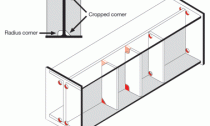Connections
Galvanized articles can be joined by bolting (including friction grip connections), welding, riveting and adhesive bonding. Bolted joints are best made after galvanizing.
Handling of articles
Depending upon size and shape, articles for galvanizing may require suspension holes or lifting lugs. They may alternatively be handled by chains or, for smaller articles, on racks or in baskets. In the case of tanks (in particular, open tanks), cross stays may be necessary to ensure the shape of the vessel is maintained during handling.
Overlapping surfaces
Overlapping surfaces should be avoided as far as possible. Care must be taken not to specify sealed articles for galvanizing. If overlaps are completely sealed by welding there is a risk of explosion during dipping due to increased pressure of any entrapped air. If overlaps are not completely sealed there is a danger of cleaning fluid entering the cavity and then weeping out and causing localised staining.
Castings
Castings must be grit blasted before galvanizing as embedded sand from the casting process cannot be removed by conventional chemical cleaning. When designing castings to be galvanized, features such as sharp corners and deep recesses should be avoided as these may develop excessive distortion and thermal stresses during hot dip galvanizing. Large fillet radii and uniform section thickness are also desirable.
Moveable parts
Adequate clearance on mating surfaces, such as hinges, should be allowed if they are to move freely after galvanizing. An extra clearance of at least 1mm is usually sufficient.
Masking
If certain areas of steelwork need to remain uncoated this can be achieved by masking, using high temperature tape, grease or paint. Again, the galvanizer should be consulted about any areas required to be masked.

